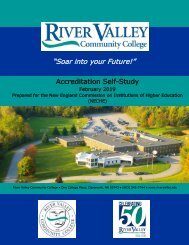Create successful ePaper yourself
Turn your PDF publications into a flip-book with our unique Google optimized e-Paper software.
Description<br />
River Valley Community College demonstrates its effectiveness by ensuring that levels of<br />
student success are satisfactory, consistent with the degree/certificate awarded, and<br />
appropriate to the College’s Mission and Purposes. The College gathers and analyzes data<br />
on many of <strong>RVCC</strong>’s expected outcomes utilizing key institution-wide student success<br />
measures, including program passage rates, academic program review, and Graduate<br />
Satisfaction Surveys. To date, data across the four locations: Claremont, Lebanon, Keene,<br />
and online are aggregated. Students at <strong>RVCC</strong> are not assigned to a specific campus, but<br />
are a member of <strong>RVCC</strong> as a whole; therefore, data collected on students is not reflective of<br />
any one location. Students often take courses in multiple locations simultaneously,<br />
particularly since the geography of the Claremont Campus and the Lebanon Academic<br />
Center are so close. For example, Business programs offer Zoom classes to allow students<br />
at any location to attend. Data relevant to these success measures will be explored fully<br />
later in this section. The Community College System of New Hampshire provides<br />
enrollment and retention data needed for program review. The Registrar’s Office provides<br />
graduate rates, IPEDS/VFA reporting, and the Academic Affairs Office has initiated<br />
strategic planning. Other departments such as the Student Success Center and Career<br />
Services, Admissions, and Academic Affairs collect specific student data important to their<br />
respective functions. Many programs evaluate data to meet their individual accrediting<br />
agency standards and the internal college program review process helps to evaluate the<br />
effectiveness of non-accredited programs. <strong>RVCC</strong> enrolls students into either certificate or<br />
degree programs as one student body.<br />
Of interest to note, and one of the reasons data collection can be confusing, is that CCSNH<br />
and <strong>RVCC</strong> use two distinct databases: IPEDS and Veera Bridge. IPEDS data is reported<br />
through the Registrar’s Office by pulling reports from Banner and is reported from July to<br />
June of the previous year. Veera Bridge pulls data from our Banner reporting system but<br />
aggregates it by semester. Banner is the CCSNH database that is used to track all aspects<br />
of individual student records from application to registration. Since <strong>RVCC</strong> follows three<br />
semesters (fall: mid-August through December, spring: January through mid-May, and<br />
summer: mid-May through mid-August); data pulled from Veera Bridge does not match<br />
exactly with IPEDS. The differences in reporting cycles sometimes leads to a slight<br />
mismatch in the numbers seen across data although both reporting systems are accurate.<br />
Data Collection, Assessment & Effectiveness<br />
College Outcomes<br />
<strong>RVCC</strong> clearly identifies the expected outcomes for the College in the College Catalog and<br />
on the website. The Expected Outcomes of the College are reflective of the mission of<br />
<strong>RVCC</strong> and identify ways in which the College works to transform lives through personal<br />
approaches to each student. <strong>RVCC</strong> is an open access college and provides access to<br />
higher education for all members of the community. At River Valley, 53% of the student<br />
population are age 21 and over. In Fall of 2017, of the 859 students enrolled at the<br />
120 | P a g e





